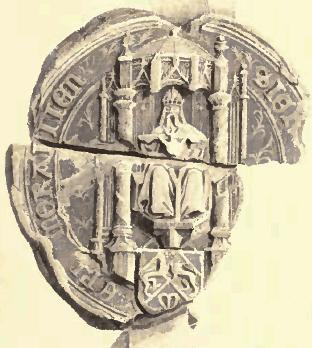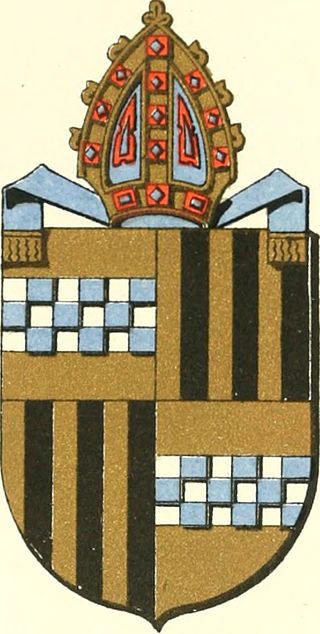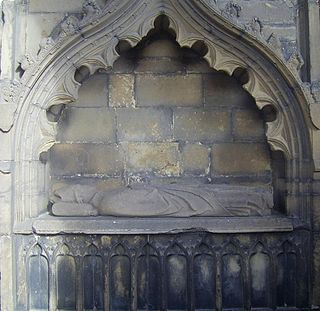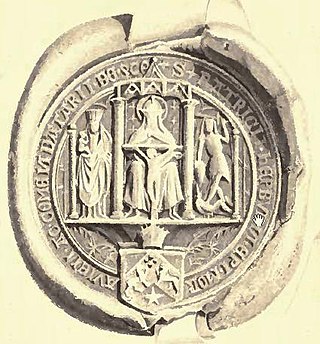
James Hepburn was a Scottish prelate and administrator. He was the son of Alexander Hepburn of Whitsome. His name occurs as the rector of Dalry and king's clerk on 1 August 1511. Hepburn was Treasurer of Scotland between from at least June 1515, until October the following year. He also held the position of rector of Parton in the diocese of Galloway.
George Brown was a late 15th-century and early 16th-century Scottish churchman. He first appears on record in 1478 as the rector of the church of Tyningham, and is called a clerk of the diocese of Brechin. In 1482, he was selected to be Chancellor of the diocese of Aberdeen.

Andrew Stewart was a 16th-century Scottish noble and cleric. He was a legitimate son of John Stewart, 1st Earl of Atholl and Eleanor Sinclair, daughter of William Sinclair, Earl of Orkney. His paternal grandmother was Joan Beaufort, former queen-consort of Scotland. Andrew chose an ecclesiastical career, held a canonry in Dunkeld Cathedral and was rector of Blair parish church, a church under the control of the earls of Atholl.
William Gordon was a 16th-century Scottish noble and prelate, the last of the pre-Reformation bishops of Aberdeen owing allegiance to the Roman Catholic Church.
Ingram Lindsay [Ingeram de Lindesay], Doctor in Canon Law, was a 15th-century Scottish cleric. Despite being of illegitimate birth - one of several sons of an unmarried nobleman and an unmarried woman - he nevertheless managed in the end to pursue a successful ecclesiastical career.

Henry de Lichton [de Lychtone, Leighton] was a medieval Scottish prelate and diplomat, who, serving as Bishop of Moray (1414–1422) and Bishop of Aberdeen (1422–1440), became a significant patron of the church, a cathedral builder, and a writer. He also served King James I of Scotland as a diplomat in England, France, and Italy.

John de Innes was medieval Scottish churchman. Born probably in Moray, he went to France in his youth, receiving a bachelorate in civil law from the University of Paris by 1396 and in canon law by 1407. His education was partly paid for by the prebend of Duffus and a grant from Alexander Bur, Bishop of Moray, taken by Bur from the judicial profits of his diocese. During Innes' study period, he was also pursuing an ecclesiastical career, being Archdeacon of Caithness from 1396 until 1398, and Dean of Ross, from some point between 1396 and 1398 until 1407.

John de Winchester was a 15th-century English cleric who distinguished himself as an administrator and bishop in Scotland. Winchester was a student of canon law from 1418, graduating with a bachelorate in 1421.
William Stewart was a late medieval Scottish prelate. Born around 1490 in Glasgow, he was the son of Thomas Stewart of Minto. Details about his early life are obscure, but it is known that he attended the University of Glasgow before travelling to continental Europe to study theology and canon law. The first benefice he held was the parsonage of Lochmaben, which he was in possession of by July 1528. In the same year he became rector of Ayr, while he had received crown presentation as Provost of Lincluden Collegiate Church in July 1529, a post he would hold along with his new position as Lord High Treasurer of Scotland.
Alexander Gordon was a late medieval Scottish churchman. He was member of the kindred of the Earl of Huntly, being cousin to the reigning earl. He was the third son of James Gordon, Laird of Haddo.

Patrick Hepburn was a 16th-century Scottish prelate. He served as both pre- and post-Reformation Bishop of Moray.
Michael Ochiltree [Ouchtre] was a 15th-century Scottish prelate and administrator. A close associate of King James I of Scotland, from the late 1410s he rose in rank from canon to Dean of Dunblane and then Bishop of Dunblane. He was responsible for the coronation of King James II of Scotland, and he obtained a grant from the crown which allowed the comparatively small diocese of Dunblane to attain historically unprecedented viability.

Alexander Bur was a 14th-century Scottish cleric. It is highly possible that Bur came from somewhere in or around Aberdeenshire, although that is not certain and is only based on the knowledge that Aberdeenshire is where other people bearing his surname come from in this period. He entered the service of King David II of Scotland sometime after 1343, perhaps as a member of David's exiled court at Château Gaillard. Although Alexander by this point in time already held prebends in both the bishopric of Aberdeen and the bishopric of Dunkeld, on that date King David petitioned Pope Clement VI for another canonry in the bishopric of Moray. Alexander had become a royal clerk and had obtained a Licentiate in Canon Law by 1350. By the latter date, upon the death of Adam Penny, Archdeacon of Moray, Alexander himself became Archdeacon.
Elisaeus Adougan was a late 14th century and early 15th century Scottish cleric. His name has been said to have occurred for the first time in a papal letter datable to 25 November 1390, but this letter is simply a repetition of another addressed to him, dated 2 August that year; both letters address him as the rector of the parish church of Kirkmahoe, and authorise him to take up the position of provost of the Collegiate Church of Lincluden providing he resigned Kirkmahoe within a period of two years.
Thomas Tulloch [de Tulloch] was a prelate active in the Kingdom of Scotland in the 15th century. A letter of Pope Martin V in 1429 claimed that he was "of a great noble race by both parents". Robert Keith believed that he had the surname "Urquhart", but that is not supported by the contemporary evidence and is probably spurious.
Robert de Fyvie [also de Fyvin] was a prelate based in the Kingdom of Scotland in the last quarter of the 13th century. Perhaps coming from Fyvie in Formartine, from a family of Teesdale origin, Robert was Archdeacon of Ross and a student at the University of Bologna by 1269. In 1275, he was not only a graduate but the new Bishop of Ross, a post he held until his death in the first half of the 1290s.
Alexander de Waghorn, Bishop of Ross, bears a surname that may suggest an origin in the Glasgow area of southern Scotland, though there are other possibilities.
Alexander de Kylwos – written alternatively as Frylquhous, Kylquos, and a variety of other forms – was a Scottish churchman and prelate active in the second half of the 14th century. He is known to have held senior positions in three bishoprics, and senior offices in two, before being elected and appointed Bishop of Ross in 1371. Though his episcopate is relatively obscure, he seems to have spent almost all of it inside or around his province, was closely associated with William III and Euphemia I, successive rulers of Ross, and was an associate of the famous Alexander Bur, Bishop of Moray, during the latter's struggle with Alexander Stewart, the son of the King later known by the nickname "Wolf of Badenoch".

James Chisholm, Bishop of Dunblane, was the eldest son of Edmund Chisholm, the first Chisholm to own the estate of Cromlix in Dunblane parish, Strathearn, having moved from the Scottish Borders. In his early years as a clergyman, he was a chaplain to King James III of Scotland; the king apparently sent him to Rome for some time.
John de Crannach was a 15th-century Scottish scholar, diplomat and prelate. Originating in the north-east of Lowland Scotland, he probably came from a family associated with the burgh of Aberdeen. Like many of his relatives, he flourished in the 15th-century Scottish church. After just over a decade at the University of Paris, Crannach became a servant of the then Dauphin Charles (VII).






